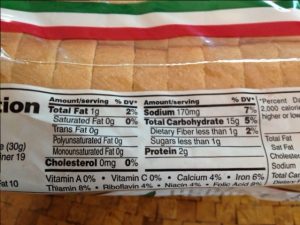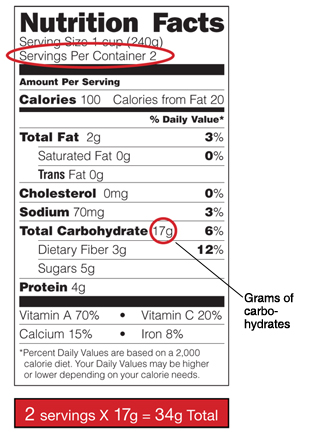40 reading food labels sugar content
Consumer understanding of sugars claims on food and drink ... The current paper focuses on nutrition claims used in food labelling, particularly sugar claims, such as 'no added sugars' and 'reduced sugars'. Such claims highlight the beneficial nutritional properties of food and drink products by providing information about energy or nutrient composition, such as low fat or high fibre. Nutrition labels: Finding out about the food you eat Sugars Fibre Protein Vitamin A Vitamin C Calcium Iron An ingredient list must list all the ingredients in a food by weight, starting with the ingredient that weighs the most and ending with the ingredient that weighs the least. The ingredient list is useful to see what ingredients are in a specific product.
Rethink Your Drink | Healthy Weight, Nutrition, and ... The next time you go grocery shopping, read the nutrition labels on the items in your cart to see which ones have the most added sugars. You may be surprised to see the amount of added sugars in some drinks. Sugary drinks are the leading source of added sugars in the American diet. These sweetened liquids include regular soda, fruit drinks ...

Reading food labels sugar content
Daily Intake of Sugar — How Much Sugar Should You Eat Per Day? Make sure to read labels and be aware that food producers often disguise added sugar using alternative names. The bottom line At the end of the day, it's important to figure out the sugar intake ... What Are Normal Blood Sugar Levels After Eating? In general, it's best to keep blood sugar below 180 mg/dL one to two hours after having a meal or snack. However, what is considered normal will vary depending on diabetes status, your age, as well as other health conditions. Carbohydrates play a significant role in blood sugar levels. How to Reverse Prediabetes, Say Experts — Eat This Not That For example, stop buying soda/pop/beverages, drink more water, start reading food labels for sugar content, add fresh fruits and vegetables, and focus on healthy breakfast and dinner (avoid sugary foods in these meals and add more protein, prime time to do so)." 2.
Reading food labels sugar content. How To Read Food and Beverage Labels | National Institute ... Most older adults exceed the recommended limits for saturated fats, sodium, and added sugars. Compare and choose foods to get less than 100% DV of these each day, making sure to adjust for how many calories are in your diet. Additionally, many older adults do not get the recommended amounts of dietary fiber, vitamin D, calcium, and potassium. Reading food labels: Tips if you have diabetes - Mayo Clinic Sugar-free foods may play a role in your diabetes diet, but remember that it's equally important to consider carbohydrates as well. A sugar-free label means that one serving has less than 0.5 grams of sugar. When you're choosing between standard products and their sugar-free counterparts, compare the food labels. How to Understand and Use the Nutrition Facts Label | FDA Single-Ingredient Sugar labels Packages and containers of products such as pure honey, pure maple syrup, or packages of pure sugar are not required to include a declaration of the number of grams... How to read labels for added sugar - That Sugar Movement Technically, 4.2g = 1 teaspoon of sugar, but for the easy on-the-spot calculation, just remember 4g equals one teaspoon. For example, a 375ml can of Coca-Cola is about 40g of sugar. Dividing that by 4 means there are 10 teaspoons of added sugar in the one can.
How to decode a food label - BBC Future The information on a processed food label may seem ... men are reading these labels and ... by simply cutting the serving size on the label, rather than the fat or sugar content. ... Food Label Reading - What You Need to Know High fiber foods have 5g or more of total fiber per serving. A good source of fiber has 2.5 to 4.9g fiber per serving. Added fiber means that 2.5g or more fiber have been added to a food. Free: Sugar-free means the food has less than 1/2g (0.5g) of added sugar per serving. Calorie-free means the food has fewer than 5 calories per serving. Sugar in Bread: What You Need to Know - The Spruce Eats Next, look at the nutrition facts label and find the Sugars or Added Sugars content—aim for as close to 0 or 1 gram per serving as possible if buying bread as a daily staple. And remember, 1 teaspoon of sugar is the equivalent to 4 grams of sugar so doing some quick math can be helpful for perspective. Lastly, an added nutritional bonus is to ... Learn How the Nutrition Facts Label Can Help You Improve ... Keep your intake of added sugars to less than 10% of your total daily calories. That means if you consume 2,000 calories in a day, added sugars should account for no more than 200 calories. Read the Nutrition Facts labels on your packaged food and drinks to keep track of sugars, fats, protein, and other nutrients.
3 Ways to Improve Your Food Label Literacy | Blogs | CDC Knowing how to read food labels is a practical skill that can help you avoid food allergens, reduce sodium and sugar in your diet, reduce food waste, and better manage your emergency food supply. Here are three ways you can improve your food label literacy. Learn to Identify Allergens. Food allergies affect millions of Americans and their families. Added Sugars on the New Nutrition Facts Label | FDA Let the Nutrition Facts Label Be Your Guide The new Nutrition Facts label can help you compare and choose foods that are lower in added sugars. Check the label to see if foods are LOW or HIGH in... Here's how much sugar you should really eat in a day - CNET "Generally speaking we want to keep added sugars to less than 10% of total calories. The recommendation for men is no more than 9 tsp. of sugar or 150 calories from added sugar daily and for women... How To Understand Nutrition Labels - CCGPN.org Make sure to read the labels on the food you eat. Here's a breakdown of what you need to know about nutrition labels. Serving Size Start off by looking at the serving size, which is the exact measurement that all the calories, fats, sugars, or sodium pertain. If the serving size is one cup, for instance, all the amounts apply to that measurement.
Reading Food Labels (for Parents) - Nemours KidsHealth A food with 5% or less of a nutrient is low in that nutrient. A food with 10%-19% of a nutrient is a good source of that nutrient. A food with 20% or more of a nutrient is high in that nutrient. The information on food labels is based on an median diet of 2,000 calories per day. But the actual number of calories and nutrients that kids need ...
Reading Food Labels - What You Need to Know The amount of sugar listed on the label is part of the total carbohydrates found in the food. Sugar includes the naturally sweet part of fruit and other foods as well as added sweeteners. Most people should limit foods high in sugar. Protein: The amount of protein in one serving is listed in grams.
How to Read Japanese Nutrition Labels - JapanLivingGuide ... How to Read Nutrition Facts on Food Product in Japan. Ingredients and nutritional facts (栄養成分表示, eiyo seibun hyouji) are usually reported on the top left of each product. They show helpful information about your food, such as protein, fat, and carbohydrates. The nutritional information found on a food label is expressed per portion ...
11 foods that have more sugar than you think - CNET Read your labels! Getty Images Truthfully, no added sugar is hidden, especially with the new nutrition facts labels that rolled out in 2020. All of the information is there for you; you just have ...
15 Most Deceptive Food Label Terms That Are Fooling You ... Shutterstock. Nutrition fact labels list carbohydrates as dietary fiber, total sugars, and sugar alcohols. These carbs provide energy in calorie form for the body. According to the FDA, the daily recommended value for carbohydrates is 275 grams, but many people choose to limit carbs for weight loss. "Low-carb" labels on foods entice dieters ...
How Much Sugar Can a Person With Diabetes Have? Men should consume no more than 36 grams of added sugar, which is about nine teaspoons or 150 calories a day. Women should limit daily added sugar consumption to no more than 25 grams of added sugar per day, which is about 6 teaspoons or 100 calories. People with diabetes should try to avoid added sugar altogether unless treating low blood sugar.
How to Read a Nutrition Facts Label | Everyday Health Most of the sugar in the American diet comes from packaged foods, such as sugar-sweetened beverages, desserts, and snacks, according to the CDC. The current dietary guidelines recommend no more...

In Conversation with Damon Gameau, Actor-Director of "That Sugar Film" | Institute of Culinary ...
Added Sugars | American Heart Association Learn more about reading food labels. Limit your consumption of foods with high amounts of added sugars, such as sugary beverages. Just one 12-ounce can of regular soda contains 10 teaspoons of sugar, or 160 calories - and zero nutrition.




Post a Comment for "40 reading food labels sugar content"